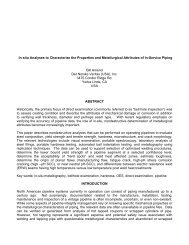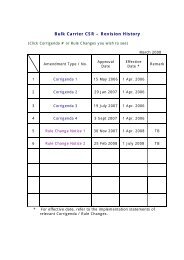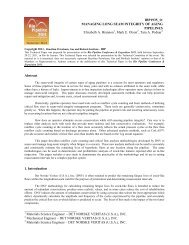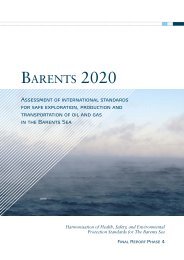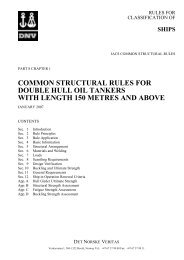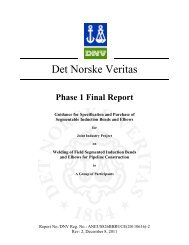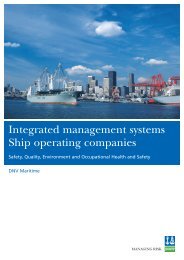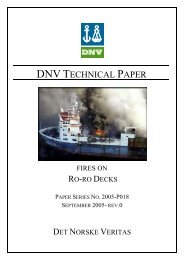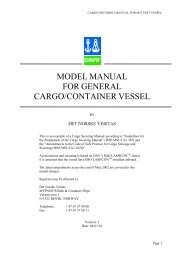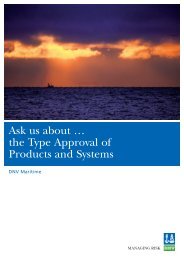The history of DNV in Greece.pdf - Det Norske Veritas
The history of DNV in Greece.pdf - Det Norske Veritas
The history of DNV in Greece.pdf - Det Norske Veritas
You also want an ePaper? Increase the reach of your titles
YUMPU automatically turns print PDFs into web optimized ePapers that Google loves.
85 years<br />
<strong>The</strong> <strong>history</strong> <strong>of</strong> <strong>DNV</strong> <strong>in</strong> <strong>Greece</strong> – 1921–2006
2<br />
85 years <strong>of</strong> active presence <strong>in</strong> <strong>Greece</strong><br />
<strong>The</strong> Norwegian Classification Society <strong>Det</strong> <strong>Norske</strong> <strong>Veritas</strong> (<strong>DNV</strong>)<br />
was founded <strong>in</strong> 1864 with headquarters <strong>in</strong> Christiania (today’s<br />
Oslo) after jo<strong>in</strong>t agreement between <strong>in</strong>surers <strong>of</strong> six different<br />
clubs. Initially ten Surveyors manned the team <strong>of</strong> the Classification<br />
Society <strong>in</strong> Oslo; the first <strong>of</strong>fice outside Norway was established<br />
<strong>in</strong> London <strong>in</strong> 1873.<br />
From 1870 until the end <strong>of</strong> the 1st World War <strong>in</strong> 1918, the<br />
Norwegian fleet classed by <strong>DNV</strong> suffered drastic changes. Sail<strong>in</strong>g<br />
ships were replaced by steamships. In this period considerable<br />
cargo was carried <strong>in</strong> Norwegian ships, at first <strong>in</strong> North Europe<br />
and North America and gradually <strong>in</strong> the Mediterranean and<br />
Black Sea, <strong>in</strong> South America and the West Indies. After the end<br />
<strong>of</strong> the 1st World War, and with 50% <strong>of</strong> the Norwegian commercial<br />
fleet destroyed (1.2 mill.grt), Norwegian shipowners started<br />
buy<strong>in</strong>g secondhand ships and plac<strong>in</strong>g orders for new construction,<br />
iron and steel <strong>in</strong> replacement <strong>of</strong> the wooden ships. Cargo<br />
shipp<strong>in</strong>g re-started after the war – mostly light cargoes <strong>in</strong> the<br />
Mediterranean, <strong>in</strong> ships which were gradually equipped with<br />
diesel propulsion.<br />
With the first Norwegian ships appear<strong>in</strong>g <strong>in</strong> the East<br />
Mediterranean, on 6 October 1919 an application was submitted<br />
to the central <strong>of</strong>fices <strong>of</strong> <strong>DNV</strong> <strong>in</strong> Oslo by I. Chandris for representation<br />
<strong>of</strong> <strong>DNV</strong> <strong>in</strong> <strong>Greece</strong>. Due to the small number <strong>of</strong> ships<br />
with <strong>DNV</strong> <strong>in</strong> the area <strong>of</strong> the East Mediterranean the decision was<br />
postponed. But demand <strong>in</strong>creased gradually and with<strong>in</strong> two
Ioannis Kourmatzis<br />
Senior Vice President<br />
Maritime South Europe<br />
Nikolaos Boussounis<br />
Vice President<br />
Maritime East Mediterranean<br />
<strong>DNV</strong> Piraeus<br />
<strong>DNV</strong> Head Office <strong>in</strong> Oslo.<br />
In 2006 <strong>DNV</strong> is major class service<br />
provider to the Greek shipp<strong>in</strong>g <strong>in</strong>dustry.<br />
<strong>DNV</strong>’s market share <strong>of</strong> the Greek order<br />
book is more than 30%.<br />
years, on 16 August 1921, the Board <strong>of</strong> Directors at the Head<br />
Office <strong>of</strong> <strong>DNV</strong> decided to create a representative <strong>of</strong>fice <strong>of</strong> <strong>DNV</strong><br />
<strong>in</strong> <strong>Greece</strong> and appo<strong>in</strong>t a Danish shipbroker, W. Wellis, with<br />
<strong>of</strong>fices <strong>in</strong> <strong>The</strong> Cunard Build<strong>in</strong>g at 4, Sotiros St. <strong>in</strong> Piraeus. It is<br />
now that the <strong>history</strong> <strong>of</strong> <strong>DNV</strong> starts <strong>in</strong> <strong>Greece</strong>. Three years later<br />
<strong>in</strong> 1924 Mr Wellis leaves <strong>Greece</strong> due to health problems and is<br />
replaced by Robert G. Knox, whose term <strong>of</strong> <strong>of</strong>fice as representative<br />
<strong>of</strong> <strong>DNV</strong> is even shorter. A few months later, Mr Knox resigns<br />
s<strong>in</strong>ce he is undertak<strong>in</strong>g service <strong>in</strong> another company. It is then<br />
that the Board <strong>of</strong> Directors <strong>of</strong> <strong>DNV</strong> hires as his successor at the<br />
end <strong>of</strong> 1924 the first Greek representative <strong>of</strong> <strong>DNV</strong>, Tasos Hatzifotiou.<br />
Mr Hatzifotiou was born on 25 February 1885 on Syros<br />
Island and graduated <strong>in</strong> Mar<strong>in</strong>e Eng<strong>in</strong>eer<strong>in</strong>g <strong>in</strong> Manchester and<br />
Middlesbrough, England. In 1906 he returns to <strong>Greece</strong> and for<br />
a decade he travels with various cargo vessels <strong>in</strong> <strong>Greece</strong>, until<br />
1916 when he receives his ticket as 1st Eng<strong>in</strong>eer. In 1917 he<br />
takes the position <strong>of</strong> Assistant Technical Manager at the repair<br />
yard <strong>in</strong> Syros, responsible for the repair <strong>of</strong> 600 ships <strong>of</strong> the<br />
British Navy dur<strong>in</strong>g the 1st World War and until 1919. After the<br />
clos<strong>in</strong>g <strong>of</strong> the shipyard he takes the position <strong>of</strong> Super<strong>in</strong>tendent<br />
<strong>in</strong> the shipp<strong>in</strong>g company Iosifoglou Brothers <strong>in</strong> Piraeus, a company<br />
with steam-powered oil tankers.<br />
From February 1921 until 1924 he works as consultant with<br />
Robert G. Knox, engaged <strong>in</strong> ship surveys and as technical<br />
expert. He rema<strong>in</strong>s a representative <strong>of</strong> <strong>DNV</strong> for 34 years until<br />
3
<strong>The</strong> first Greek ship to <strong>DNV</strong> class, the tanker “Spiros” built <strong>in</strong> 1928.<br />
4<br />
1958, when he retires from active service as a non-exclusive surveyor<br />
to <strong>DNV</strong>.<br />
On 18 January 1958 the Directors appo<strong>in</strong>t Filipos Pittas, orig<strong>in</strong>ally<br />
from Alexandria, Egypt, as a representative <strong>of</strong> <strong>DNV</strong>.<br />
Born to Greek parents <strong>in</strong> Alexandria, Pittas was a dist<strong>in</strong>guished<br />
member <strong>of</strong> the Greek community <strong>in</strong> Egypt. He graduated<br />
as Mar<strong>in</strong>e Eng<strong>in</strong>eer and Naval Architect from the University<br />
<strong>of</strong> Durham <strong>in</strong> England <strong>in</strong> 1931, the only graduate that year.<br />
After a short sea-go<strong>in</strong>g service he returns to Egypt <strong>in</strong> 1931 and<br />
resumes position <strong>of</strong> Technical Manager at the Shipyards <strong>of</strong><br />
Zacharis <strong>in</strong> Alexandria, contribut<strong>in</strong>g among other th<strong>in</strong>gs to the<br />
repair <strong>of</strong> allied forces’ naval ships dur<strong>in</strong>g the 2nd World War.<br />
For this contribution he receives a medal from the British M<strong>in</strong>istry<br />
<strong>of</strong> Defence after the war.<br />
After the revolution <strong>in</strong> Egypt and the mass evacuation <strong>of</strong><br />
Greek Egyptians, Pittas moves to Athens <strong>in</strong> 1958. <strong>The</strong>re he<br />
beg<strong>in</strong>s to build up the future <strong>of</strong> <strong>DNV</strong> work<strong>in</strong>g at the same time<br />
as a technical consultant for the Salvage Association and American<br />
underwriters. <strong>The</strong> period after 1944 is characterised by the<br />
effort <strong>of</strong> Greek shipowners to rebuild the Greek fleet, 75% <strong>of</strong><br />
which were destroyed dur<strong>in</strong>g the war. A good start is made by<br />
the grant <strong>of</strong> one hundred Liberty ships, given by the American<br />
Government to <strong>Greece</strong> as part <strong>of</strong> a restoration programme <strong>in</strong><br />
support <strong>of</strong> damage which <strong>Greece</strong> suffered dur<strong>in</strong>g the War.<br />
Dur<strong>in</strong>g the period 1950–60, Greek shipowners are active <strong>in</strong><br />
secondhand ship purchases, most <strong>of</strong> which are from Scand<strong>in</strong>a-
<strong>The</strong> first Greek Newbuild<strong>in</strong>g to<br />
<strong>DNV</strong> Class: Bulk Carrier “Spyros A.<br />
Lemos”, built 11/1968.<br />
vian owners and already to <strong>DNV</strong> class. At first most <strong>of</strong> the ships<br />
change class but gradually and thanks to the dynamic presence<br />
<strong>of</strong> <strong>DNV</strong> and Filipos Pittas <strong>in</strong> Piraeus, Greek shipowners are<br />
becom<strong>in</strong>g familiar with <strong>DNV</strong> and gradually reta<strong>in</strong> the orig<strong>in</strong>al<br />
class.<br />
<strong>The</strong> first Greek ship which appears <strong>in</strong> the Register <strong>of</strong> <strong>DNV</strong> is<br />
the tanker Spiros which was bought by Ioannis Latsis Ltd. <strong>in</strong><br />
1958. In 1959 the Greek Mediterranean L<strong>in</strong>es (Elmes) buys the<br />
general cargo ships Massalia and Thiseas both with <strong>DNV</strong> class,<br />
and shipowners such as M. Karagiorgis, M. Goulandris, A. G.<br />
Papadakis, Pateras and others become <strong>DNV</strong> clients <strong>in</strong> the early<br />
1960s.<br />
In November 1968 Capta<strong>in</strong> N. Lemos from AVRA MAR-<br />
ITIME builds at Uddevalla Sweden, the first Greek vessel to <strong>DNV</strong><br />
Class. This is a 55000 KDWT Bulk Carrier, trad<strong>in</strong>g for 28 years<br />
before demolition.<br />
In 1965 Pittas appo<strong>in</strong>ts as secretary Mrs Lena Petropoulou<br />
(later Olympiou) and two years later <strong>in</strong> 1967 as a technical assistant<br />
I. Mihalelis. Pantelis Karavidas is an <strong>of</strong>fice assistant until he<br />
retires <strong>in</strong> 1971. In 1971 with the three above as the core <strong>of</strong><br />
<strong>DNV</strong>’s <strong>of</strong>fice, and with the rapid <strong>in</strong>crease <strong>in</strong> work for <strong>DNV</strong> <strong>in</strong><br />
<strong>Greece</strong>, the Directors decide to change the status <strong>of</strong> the <strong>of</strong>fice<br />
from representative to exclusive. <strong>DNV</strong> Piraeus jo<strong>in</strong>s the network<br />
<strong>of</strong> exclusive <strong>of</strong>fices <strong>of</strong> the Classification Society with Pittas as<br />
chief representative. In the meantime the <strong>of</strong>fice changes location<br />
from its orig<strong>in</strong>al location s<strong>in</strong>ce 1958, at 2, Emmanouel<br />
5
6<br />
Repouti St. to 102 Pip<strong>in</strong>ou St. <strong>in</strong> Athens, and <strong>in</strong> 1967 to the<br />
premises <strong>of</strong> Laiki Bank <strong>in</strong> Piraeus (Vatis Build<strong>in</strong>g). In 1969 the<br />
<strong>of</strong>fice, now the first exclusive <strong>of</strong>fice <strong>of</strong> <strong>DNV</strong>, is relocated to 9,<br />
Sotiros St., Piraeus, and <strong>in</strong> August 1971 a Norwegian surveyor,<br />
Hans Viig, arrives as a tra<strong>in</strong>ee and stays for three years until the<br />
summer <strong>of</strong> 1974. Viig is the first Norwegian Surveyor <strong>in</strong> <strong>Greece</strong>;<br />
he is a third generation employee from the Viig family work<strong>in</strong>g<br />
for <strong>DNV</strong>. Together with his father and grandfather the Viig family<br />
has served <strong>DNV</strong> for more than 120 years.<br />
In 1973, thanks to Pittas’ <strong>in</strong>itiative and with the cont<strong>in</strong>uous<br />
growth <strong>of</strong> shipowners us<strong>in</strong>g <strong>DNV</strong> as their Classification Society,<br />
the first Greek Committee <strong>of</strong> <strong>DNV</strong> is established. Chairman <strong>of</strong><br />
the committee is the shipowner Costas M. Lemos, reta<strong>in</strong><strong>in</strong>g this<br />
position for 18 years. <strong>The</strong> same year the first Greek tra<strong>in</strong>ee surveyor,<br />
S<strong>of</strong>oclis Digenis, is added to the personnel <strong>of</strong> the <strong>of</strong>fice <strong>in</strong><br />
<strong>Greece</strong> after completion <strong>of</strong> his tra<strong>in</strong><strong>in</strong>g period <strong>in</strong> Oslo and<br />
Cadiz <strong>in</strong> Spa<strong>in</strong>. In 1974 Hans Viig departs for Hong Kong and is<br />
replaced by the Norwegian T. H. Hansen who rema<strong>in</strong>s <strong>in</strong> <strong>Greece</strong><br />
for only one year. After his departure <strong>in</strong> 1975 another Greek<br />
surveyor is hired, Vasilis Karagiannis.<br />
<strong>The</strong> construction <strong>of</strong> large cargo vessels for <strong>in</strong>ternational service<br />
began <strong>in</strong> <strong>Greece</strong> <strong>in</strong> 1960, with World Hope owned by Niarchos.<br />
This is the first vessel built at Skaramanga Shipyard. 15<br />
years later <strong>in</strong> 1975, <strong>DNV</strong> is called to supervise for the first time<br />
the construction <strong>of</strong> a cargo ship <strong>in</strong> <strong>Greece</strong> accord<strong>in</strong>g to its rules.<br />
This ship is constructed at the United Shipyards <strong>in</strong> Perama P & I,
Nauticus on board delivers the right<br />
<strong>in</strong>formation to shipowners and managers<br />
at the right time, anywhere.<br />
<strong>The</strong> Greek <strong>DNV</strong> team, from left<br />
A. Efstathiou, C. Vlachiotis, N. Boussounis,<br />
A. Pagalos, L. Isaias, I. Kourmatzis and J. Kouthouris.<br />
and is a general cargo, open-hatch ship named Frendo United.<br />
At the end <strong>of</strong> this year, after a successful pr<strong>of</strong>essional career as<br />
consultant and as a <strong>DNV</strong> representative for 17 years, Pittas leaves<br />
his position. <strong>DNV</strong>’s adm<strong>in</strong>istration decides then to upgrade<br />
Piraeus to a regional <strong>of</strong>fice, responsible for <strong>Greece</strong> and Cyprus,<br />
with its first Regional Manager, <strong>The</strong>odor Wilse.<br />
Wilse was born <strong>in</strong> 1918 and lived an eventful and colourful<br />
life. At the age <strong>of</strong> eight he moved to Ch<strong>in</strong>a where his father<br />
lived for 29 years. Dur<strong>in</strong>g the years from 1926 to 1929 he found<br />
himself <strong>in</strong> the middle <strong>of</strong> the Ch<strong>in</strong>ese Revolution and his family<br />
was rescued by English and American ships which protected the<br />
Europeans at Pei Ta Ho from the battles between Tsan Kai<br />
Sheck and the northern army <strong>of</strong> Tsang Sho L<strong>in</strong>g. Wilse graduated<br />
<strong>in</strong> 1943 as Naval Architect and Mechanical Eng<strong>in</strong>eer from<br />
Trondheim and worked on whalers, as a welder and as technician<br />
at shipyards before jo<strong>in</strong><strong>in</strong>g <strong>DNV</strong>. He became well-known <strong>in</strong><br />
1975 when he was elected as a member <strong>of</strong> a tribunal to conduct<br />
<strong>in</strong>vestigations as an expert on the loss <strong>of</strong> large vessels such as<br />
Berge Istra and Betelgeuse. Wilse was a good manager, a good<br />
man but above all a great “Fillel<strong>in</strong>as”.<br />
<strong>The</strong> mid-1970s is the period when <strong>DNV</strong> decides to become<br />
<strong>in</strong>ternational and to enter markets outside <strong>of</strong> the traditional borders<br />
<strong>of</strong> Scand<strong>in</strong>avia. As a first step <strong>DNV</strong> establishes a systematic<br />
tra<strong>in</strong><strong>in</strong>g programme for young graduates from countries with<br />
great naval traditions, such as <strong>Greece</strong>. This two-year education<br />
programme takes place <strong>in</strong> Oslo, Norway which <strong>in</strong> those days was<br />
7
8<br />
considered (and was) a remote corner <strong>of</strong> Europe.<br />
In the two follow<strong>in</strong>g years, 1974–76, four graduates are hired<br />
from colleges and universities, Christos Barakos, Alexandros Kyriazis,<br />
Nikos Liapis, and Ioannis Kourmatzis. All (except Liapis,<br />
who is deceased) are still employees <strong>in</strong> <strong>DNV</strong> today. In 1977 the<br />
<strong>of</strong>fices <strong>of</strong> the Classification Society are transferred for one more<br />
time to 5–7, Fillel<strong>in</strong>on St. <strong>in</strong> Piraeus, and with the return <strong>of</strong> the<br />
tra<strong>in</strong>ees, the number <strong>of</strong> employees grows to ten – eight technical<br />
and two secretaries.<br />
In the early 1980s, adm<strong>in</strong>istrative decentralisation takes place<br />
and five new divisions are created, with Europe be<strong>in</strong>g one <strong>of</strong><br />
those. Ste<strong>in</strong> T. Verle is the divisional head for Europe. He is an<br />
energetic, dynamic and foresighted manager who sees immediately<br />
the possibilities for further expansion <strong>in</strong> the Greek market.<br />
With his <strong>in</strong>itiative, a service centre is established <strong>of</strong>fer<strong>in</strong>g technical<br />
consultancy services and customer services for Greek<br />
shipowners, besides the traditional classification services <strong>of</strong>fered<br />
by <strong>DNV</strong>. For this reason <strong>in</strong> 1980–81 six new surveyors/tra<strong>in</strong>ees<br />
are hired: G. Demos, N. Boussounis, D. Protopsaltis, H. Vlachodimitris,<br />
M. Lavidas and C. Vlachiotis; all but one are still<br />
work<strong>in</strong>g for <strong>DNV</strong>.<br />
<strong>The</strong> <strong>of</strong>fice is organised <strong>in</strong>to two different departments: a<br />
department responsible for surveys with S. Digenis <strong>in</strong> charge (he<br />
had just returned from a two-year transfer from Rotterdam) and<br />
the Service Centre department with I. Kourmatzis <strong>in</strong> charge.<br />
Due to the rapid growth <strong>of</strong> <strong>DNV</strong> activities at the beg<strong>in</strong>n<strong>in</strong>g <strong>of</strong>
<strong>DNV</strong>’s customer service management is designated to support<br />
customers with all <strong>DNV</strong> services to their ships worldwide.<br />
the 1980s, the number <strong>of</strong> employees grows from 10 to 20 <strong>in</strong> four<br />
years. <strong>The</strong> <strong>of</strong>fice is relocated to a new address on two floors at<br />
27–31 Hatzikiriakou St., and at the same time T. Wilse retires<br />
and is replaced by B. Øvrebø for a transitional period <strong>of</strong> less<br />
than a year and eventually by Dane Mr P. B. Hansen <strong>in</strong> the<br />
Spr<strong>in</strong>g <strong>of</strong> 1982.<br />
<strong>The</strong> period 1982–85 is marked by a successful attempt <strong>of</strong> the<br />
Society <strong>in</strong> <strong>Greece</strong> to <strong>in</strong>crease its market share, and to ga<strong>in</strong> the<br />
preference <strong>of</strong> Greek shipowners. <strong>The</strong> ma<strong>in</strong> aim is to change the<br />
perception <strong>of</strong> the market that <strong>DNV</strong> can be used only for class<strong>in</strong>g<br />
secondhand vessels bought from Scand<strong>in</strong>avian owners. This is<br />
the period when market share reaches 10% <strong>of</strong> Greek-owned<br />
ships classed with <strong>DNV</strong>. A large number <strong>of</strong> class transfers take<br />
place dur<strong>in</strong>g this period, as well as the construction <strong>of</strong> the second<br />
ship with <strong>DNV</strong> class <strong>in</strong> <strong>Greece</strong>, Lanado, a vessel for oil<br />
reception facilities.<br />
In 1985 the Danish Regional Manager is replaced by the<br />
Swedish Ingvar Lilja, who was to have the longest term as<br />
Regional Manager <strong>in</strong> <strong>Greece</strong>. He rema<strong>in</strong>ed <strong>in</strong> <strong>Greece</strong> until<br />
1996, when he moved to the USA. He had an <strong>in</strong>terest<strong>in</strong>g background<br />
as mar<strong>in</strong>e capta<strong>in</strong> and lawyer and knew the Greek culture<br />
well, as he had worked <strong>in</strong> <strong>Greece</strong> for a Middle East owner<br />
prior to jo<strong>in</strong><strong>in</strong>g <strong>DNV</strong>. He was a “ref<strong>in</strong>ed person”, a diplomat, a<br />
true gentleman and had Greek shipp<strong>in</strong>g <strong>in</strong> his heart.<br />
Meanwhile <strong>in</strong> 1991 the <strong>of</strong>fices <strong>of</strong> <strong>DNV</strong> move to today’s<br />
address at 26–28, Akti Kondyli <strong>in</strong> Piraeus. After 1996 the new<br />
9
10<br />
Regional Manager is the Swedish Ulv Tigerstedt, a very experienced<br />
<strong>DNV</strong> employee with long service. He comes to <strong>Greece</strong> follow<strong>in</strong>g<br />
a four-year assignment as Regional Manager <strong>in</strong> Korea,<br />
and br<strong>in</strong>gs with him wide experience from Far East yards. This is<br />
very timely as it co<strong>in</strong>cides with boom<strong>in</strong>g newbuild<strong>in</strong>g orders<br />
from Greek owners at Far East yards. Tigerstedt proves to be a<br />
fair and well-rounded person, <strong>in</strong>spir<strong>in</strong>g and motivat<strong>in</strong>g employees<br />
and <strong>in</strong>still<strong>in</strong>g team spirit. Together with N. Boussounis and<br />
M. Lavidas as managers <strong>of</strong> Piraeus district and Safety Management<br />
departments respectively, he systematically widens <strong>DNV</strong>’s<br />
market. <strong>The</strong> last ten years after 1995 are sealed with success <strong>in</strong><br />
all <strong>of</strong> the Society’s fields <strong>in</strong> <strong>Greece</strong>. <strong>The</strong> mass turn <strong>of</strong> Greek owners<br />
from 1997 to newbuild<strong>in</strong>gs gives a chance to <strong>DNV</strong> to <strong>in</strong>crease<br />
its market share from 11% to 18.5% <strong>of</strong> the Greek market, i.e. a<br />
total fleet capacity <strong>of</strong> 20 mill.grt <strong>of</strong> ships are classified with <strong>DNV</strong><br />
<strong>in</strong> 2005. In 1998 for the first time two Greek employees, I. Kourmatzis<br />
and S. Digenis, are promoted to the grade <strong>of</strong> Vice President.<br />
<strong>The</strong> same year I. Kourmatzis is appo<strong>in</strong>ted as responsible<br />
for Bus<strong>in</strong>ess Area Maritime at Oslo Headquarters <strong>in</strong> charge <strong>of</strong><br />
policy, strategy, research and technology <strong>in</strong> the area <strong>of</strong> maritime<br />
bus<strong>in</strong>ess worldwide.<br />
Ulv Tigerstedt rema<strong>in</strong>s as Regional Manager <strong>in</strong> Piraeus until<br />
the beg<strong>in</strong>n<strong>in</strong>g <strong>of</strong> 2000, and is then replaced by S<strong>of</strong>oclis Digenis,<br />
the first Greek to become Regional Manager for the area <strong>of</strong> East<br />
Mediterranean and the Black Sea.<br />
In the summer <strong>of</strong> 2001 there is an extensive re-organisation
A picture from Piraeus Maritime<br />
Academy and Tra<strong>in</strong><strong>in</strong>g Session.<br />
<strong>of</strong> the <strong>in</strong>ternational field network <strong>of</strong> <strong>DNV</strong>. As a result <strong>in</strong> the<br />
autumn <strong>of</strong> 2001 Piraeus is upgraded to adm<strong>in</strong>istrative centre <strong>of</strong><br />
South Europe. <strong>The</strong> area <strong>in</strong>cludes 25 countries and the new management<br />
team <strong>of</strong> <strong>DNV</strong> consists <strong>of</strong> only Greek employees. New<br />
Regional Manager for South Europe is I. Kourmatzis, with Manager<br />
for the East Mediterranean N. Boussounis.<br />
<strong>The</strong> follow<strong>in</strong>g five years from 2001 to 2006 are marked by a<br />
considerable growth <strong>of</strong> <strong>DNV</strong> <strong>in</strong> <strong>Greece</strong>. Total number <strong>of</strong><br />
employees is close to 60. Greek surveyors are now serv<strong>in</strong>g Greek<br />
owners world-wide with extensive travel<strong>in</strong>g to places as far as<br />
Ch<strong>in</strong>a/Vietnam and South America, whilst at the same time ship<br />
repairs and their major survey jobs <strong>in</strong> <strong>Greece</strong>, are on decl<strong>in</strong>e<br />
due to labor cost <strong>in</strong>crease. Greek owners cont<strong>in</strong>ue the spree <strong>of</strong><br />
newbuild<strong>in</strong>gs, ma<strong>in</strong>ly <strong>in</strong> Korea and to a lesser degree <strong>in</strong> Ch<strong>in</strong>a/<br />
Japan, with <strong>DNV</strong> gett<strong>in</strong>g more than their fair-share, at about<br />
30% <strong>of</strong> all Newbuild<strong>in</strong>gs.<br />
<strong>DNV</strong> Piraeus establishes dur<strong>in</strong>g this period a Maritime Academy<br />
for external tra<strong>in</strong><strong>in</strong>g with more than 3000 participants <strong>in</strong><br />
more than 200 highly technical/managerial courses.<br />
11
<strong>Det</strong> <strong>Norske</strong> <strong>Veritas</strong><br />
NO-1322 Høvik<br />
Norway<br />
Tel: +47 67 57 99 00<br />
www.dnv.com<br />
For more <strong>in</strong>formation contact:<br />
<strong>DNV</strong> Piraeus, 26-28 Akti Kondyli, Piraeus 18545, <strong>Greece</strong><br />
Tel: +30 210 41 00 200, Fax: +30 210 42 26 708<br />
PirMar@dnv.com<br />
www.dnv.com/maritime<br />
5-2006 Coor Graphic Communications 0602-035<br />
Pr<strong>in</strong>t: GAN Grafisk





